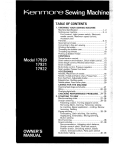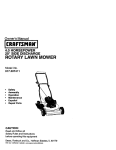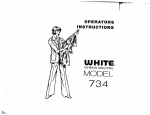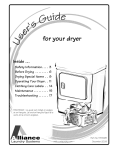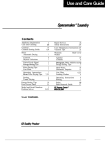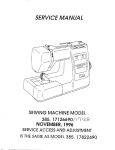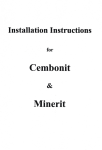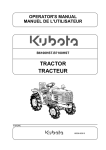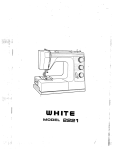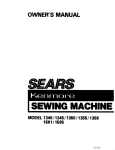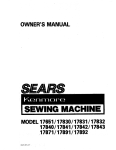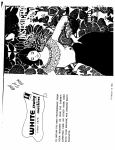Download HTC PB00100 Cell Phone User Manual
Transcript
Kenmo?e SEWING MACHINE MODEL 17921 55d7c/ Sears, Roebuck and Co. Dear Homemaker: You have just invested in a very fine zigzag sewing machine. Before using your new Kenmore machine, please pause for a moment and carefully read this booklet which contains instructions on how to operate and care for your machine. Specific instructions are given on threading, tension adjustments, cleaning, oiling, etc. This will help you obtain the best sewing results and avoid unnecessary service expense for conditions beyond our control. Advice on the operation and care of your machine is always available at your nearest Sears Retail Store. Please remember, if you have questions about your machine, atways mention the model number and serial number when you inquire. Kenmore Sewing Machine Record in space provided below the model number and serial number of this appliance. The model number and serial number are located on the nomenclature plate, as identified on Page 3 of this booklet. Model No. Serial No. Retain these numbers for future reference. YOUR SEWING PLACE IS ALWAYS READY SEARS KENMORE SEWING FURNITURE Sewing machine cabinet is available at your nearest Sears retail store or through our general catalog. Whenever you're ready to sew, so is your sewing plaCe, Another option.., buy a Carrying Case... then your Kenmore goes anywhere, can be stored anywhere. WITH TABLE OFCONTENTS = KNOWING YOUR SEWING MACHINE Machine identification .............................................. Setting up your machine ........................................... Foot control, Light/power switch, Electronic needle control, Maximum speed control, Accessory box Parts list................................................................ Spool pins and caps ................................................... Converting to free-arm sewing ...................................... Winding the bobbin .................................................... Threading the bobbin case ........................................... Picking up bobbin thread ............................................. Threading top thread .................................................. Picking up bobbin thread ............................................. 6- 7 8 8 9 10 12 11 12 CONTROLS Thread _ension control ................................................ Stitch selector and indicator, Stitch width control.............. Stitch length control, Reverse stitch lever, Stitch modifier ... Buttonhole control, Pressure regulator............................ Seam guides, Presser foct lever .................................... 13 14 15 16 17 ACCESSORIES Needles, Placement of needle....................................... Needle, thread and fabric chart, Presserfeet .................... Even feed foot, Adjustable holder .................................. Edgestitcher, Quilting guide ......................................... Needle plates, Feed cover plate ..................................... 18 19 20 21 22 CARING FOR THE MACHINE Cleaning feed dogs and shuttle ..................................... Oiling ....................................... . ........................ Changing light bulb .................................................... CHECKING PERFORMANCE PROBLEMS .............. . 2- 3 4- 5 23 24 - 25 25 26- 27 STARTING TO SEW ................................................. 28 Machine setting chart ................................................. 29 Straight stitching ................................................. 29 - 34 Fastening a seam, Turning a square corner, Removing fabric, Top-stitching, darning, Temporary sewing by machine, Zipper application-cording, Narrow hemming, Quilting Zigzag stitching .......................... _........................ 35 - 38 Overcasting, Satin stitching, Bar tacking, Appliqueing, Embroidery, Monogramming, Button sewing Mending and overcast stitching..................................... 39 Box stitch ................................................................ 40 Blind hemming ..................................................... 41 - 42 Scallop stitch ............................................................ 43 Stretch stitches ................................................... 44 - 47 Adjusting stitch length, Adjusting stitch balance, Straight stretch stitch, Rick-rack stretch, Feather stretch, Smocking stretch, Elastic stretch, Overcast stretch, Paris point stretch Getting the most from fabrics that give ...................... 48 - 49 Hints on sewing different fabrics ................................... 49 Buttonhole making ............................................... 50 - 58 Decorative Embroidery designs......... '....................... 59- 60 WARRANTY ........... ;.......................... Inside back cover 1. KNOWING YOUR SEWING MACHINE IDENTIFICATION CHART Top thread tension control Foldaway carrying handle Bobbin winder tension disc \ Slotted take-up levew Built-in buttonhole control Bobbin winder shaft Bobbin winder latch Threading channel Face cover Stitch width dial • i,?. Stitch indicator Check spring Thread Stitch selector guide__ Reverse Needle clamp stitch lever screw .... Presser foot Needle plate Stitch Needle up/down , Feed dogs Bobbin cover plate. Bobbin window Basting Maximum Accessory box length dial switch switch speed control .J[ Telescoping spool pin _ i Rear thread guide ,, ,,.............. Swing-away Hand wheel/ push-pull _ spool pin _'_nm_'Presser foot lever clutch Presser foot lock Thread cutter Nomenclature Light/power Foot control swit_ Electric cord rece; box Foot control -._----- Buttonholer! accessory Foot pedal Cord receptacle _' Owner's manual Pedal lock knob Machine Power-line plug plug Foot control plug 3 SETTING . . . Fig. 1 UP YOUR MACHINE Install your Kenrnore sewing machine in a Kenmore cabinet, case or set the machine on a sturdy flat surface. Your Kenmore sewing machine has been thoroughly oiled at the factory. Be sure to wipe off the needle plate area and bed plate carefully before sewing a garment. It is wise to practice on a scrap of fabric so any surplus oil is absorbed. FOOT CONTROL Your machine is supplied with an electronic foot control which enables you to sew very slowly. Even at low speed you have extra power for the needle to penetrate through several thicknesses of fabric. Faster speeds are also easily controlled. 1. Pull out the foot control from its storage position under the free arm. (Fig. 1) 2. Slide pedal lock knob to the right and the foot pedal will pop up to its operating position. Push foot control plug into the cord receptacle on the foot control. (Fig. 2) 3. Push machine plug into the cord receptacle at the rear side of the machine. Then connect power-line plug into any 110-120 volt A.C. wall outlet. (Fig. 2) . Light/power Foot Pedal Iock._nob pedal It Fig. 2 4 LIGHT/POWER SWITCH Your machine will not operate unless the light/power switch is turned on. This same switch controls the machine power, sewing light and indicator lights on the stitch indicator panel and electronic needle control. If you are interrupted or stop sewing, turn off the switch. 5. ELECTRONIC NEEDLE CONTROL Your machine is electronically controlled to stop with the needle in the up position every time you remove pressure from foot control. Electronic control NEEDLE UP/DOWN SWITCH If you wish the machine to stop with the needle in the down position (as in turning a corner), push the left switch. A red light will appear showing you that the machine is so set. To return to the Needle Up position push the left switch again and when the light disappears, machine is again set to stop with the needle in an up position each time. BASTING SWITCH Tap the foot control with the right switch pushed and lighted and the machine will take one stitch only and stop with needle in the up position. This feature provides an electronically controlled basting or tacking to take the chore out of hand basting. ° . MAXIMUM SPEED CONTROL You may want to vary the speed of the machine, sewing slowly in special tight places or if you are a new seamstress. This control can be moved to the left to slow the sewing of the machine. To increase to the maximum speed, slide the control to the right. needle .... i- B II '' I electronic I ' DiD I 0 0 0 . _" Decrease Increase Maximum speed control ACCESSORY BOX Accessory box is opened by lifting the lid up and swinging it toward you as shown. Inside you will find many of the accessories that you use each time you sew. The box may be fully removed from the machine to convert it for free arm stitching. See page 8. 5 PARTS LIST (Use only genuine Kenmore replacement parts and accessories.) All parts listed herein may be ordered from any Sears, Roebuck and Co. store or service center. 3. MODEL NUMBER shown on the nomenctature plate. (See page 3 for location.) WHEN ORDERING REPAIR ALWAYS GIVE THE FOLLOWING MATION: 1. PART NUMBER 2. PART DESCRIPTION If the parts you need are not stocked locally, your order will be electronically transmitted to a Sears Repair Parts Distribution Center for expedited handling. PARTS, INFOR- 4. NAME OF ITEM PRESSER FEET 3 Straight Stitch (No. 45171) Standard Zigzag (No. 44985) "Q SET" (No. 6858) Zipper Foot (No. 6759) Satin Stitch (No. 44988) Blind Hem Foot (No. 6886) Plastic Satin Stitch (No. 43776) Overcasting (No. 35094) * Included BUTTONHOLE * Even Feed Foot (No. 6888) in the buttonholer box ACCESSORIES Built-in Buttonhole Guide Foot (No. 43840) Buttonhole Cover Plate (No. 58210) 6 "Q FOOT" (No. 6843) Buttonhole Guideplate (No. 58232) Buttonhole Foot (No. 41040) Buttonhole Opener (No. 6830) B uttohole Templates No. 1 Part45195 No. 2 Part 45196 NO. 3 Part 45197 No. 4 Part 45198 No. 5 Part 45199 OTHER VITAL ITEMS i _. Straight Stitch Zigzag Needleplate Needleplate (No. 57861 ) (No. 57860) Narrow Hemmer ( No. 29396) Feed Cover Plate (No. 43166) 2 Spool Pin Caps Large - No. 55503 Small -- No. 53871 Quilting Guide (No. 351051 Edge Stitcher (No. 29306) Nylon Disc (No. 2273) Lint Brush (No. 35848) Bobbin Winder Rubber Ring (No. 1913) Adjustable Holder (No. 29308) large Screw Driver (No. 55501) , Small Screw Driver (No. 55500) Magnetized Mini Screw Driver (No. 55499) Bobbin Winder Tension Disc (No. 39619) OPTIONAL Light Bulb (No. 6797) Foot Control Cord (No. 57543) ACCESSORIES Packet of needles with your machine includes a variety of sizes. Replacement needles come in packages of one size only. Ruffler/Pleater (No. 6895) Foot Control (No. 57544) Needle Size Part No. No. 9 6550 No. 11 6551 No. 14 6552 No. 16 6553 No. 18 6554 "Q NEEDLE" 6746 Double Needle 6749 Hinged Zipper Foot (No. 6794) Bobbin 10 Metal (No. Plastic (No. Box with Bobbins 6862) Bobbins 6868) Needle Threader (No. 43780) 7 SPOOL PINS AND CAPS Telescoping spool pin Spool cap Nylon Swing the Primary Spool Pin into position at the back of the machine as shown above. Place a spool of thread on the pin and place the appropriate size spool cap over the thread. CONVERTING TO FREE-ARM SEWING This machine can be used either as a flatbed or as a freearm model. With the accessory box in place, the machine is a flatbed model with a large working surface, which slopes gently towards you to help the smooth flow of fabric. . 8 A second telescoping spool pin is provided for bobbin winding and for a second thread when sewing with a double needle. Pull it out and place a nylon disc over it when using. To remove the accessory box, take it firmly with your left hand and lift it up until it clicks. Your machine is then ready for free arm sewing. By removing the accessory box, the machine converts into a slim freearm model for sewing children's clothes, cuffs, trouser legs, armholes and other awkward places. 2. To replace, slide the accessory into place until it clicks. box back WINDING THE BOBBIN O ® ® l . Place thread on Telescoping Spool Pin. Draw thread through Rear Thread Guide and Bobbin Winder Tension Disc as indicated. . Pull end of thread through any hole in bobbin; place bobbin on Bobbin Winder Shaft with end of thread coming from top of bobbin as shown above. Pull out to . Push Bobbin Winder Latch against bobbin until it clicks. Then pull Hand Wheel away from machine to disengage clutch (see diagram below). Hold end of thread coming from bobbin (see above) and step on foot control. After several rotations of bobbin release thread. . When bobbin is full, winding stops automatically. Push in Hand Wheel. Remove bobbin from shaft and trim thread end. Treat Hand Wheel as a "'clutch" It controls the needle mechanism so that when pulled out (disengaged), the rest of the machirLe will not operate while the bobbin is being wound. isengage Push in to engage For best stitching results use clear plastic lightweight bobbins when stitching at high speed with widest and longest stitch setting. 9 THREADING THE BOBBIN CASE ® ® ® ® 1. Remove accessory box. 2. Remove bobbin the front. cover plate by lifting Pull thread through slot about 4 inches of thread. 6. Replace bobbin thread to emerge plate. (B) and leave up 3. Insert bobbin into bobbin case making sure bobbin rotates counter clockwise. 4. Pull thread through the left. 10 5. slot (A) and then to cover plate allowing through slot in needle THREADING TOP THREAD Fig. 1 [ In'_ °=.'_/ ' = III llF . .i ili........ • i._ i _._, !-i_ :i i_ol Fig. 2 , Raise slotted take-up lever to its highest position. Place thread spool onto spool pin. Place appropriate spool cap over the spool of thread. Draw thread through rear thread guide (A) and into threading channel (B) toward you. (Fig. 1) Fig. 3 , . Draw thread down and around check spring (C) and up through slotted take-up lever (D). (Fig. 2) Draw thread down into thread guides (E) and (F). Thread needle from front to back as shown in Fig. 3. 11 PICKING UP BOBBIN THREAD 1. Raise presser foot lever. Hold needle thread loosely in left hand and push,!_eedle up/down switch two times or rotate hand wheel toward you one complete turn. 2. ® Bring bobbin thread thread. up by pulling upper / . ® Pull both threads under and to the back of the presser foot, leaving 3 to 4 inches of thread clear. / \ \ If yOu can not pick up bottom thread following above steps, then check: 1. Is needle threaded ? 2. by Is thread tangled around needle ? 3, Is bobbin case threaded correctly with thread going through slots A and B as shown on page 10, Fig. 4 and 5 ? 4. Is there 4 inches of thread coming from bobbin case and through slot of needle plate as shown on page 10, Fig. 6 7 5. Is thread from bobbin case tangled ? 12 CONTROLS THREAD STRAIGHT TENSION CONTROL STITCHING STRAIGHT STITCH JUST RIGHT The good looking appearance of your straight stitching is, mainly determined by the balanced tension of the top thread and bobbin thread. The tension is well balanced when the two threads lock in the middle of the layers of fabric when straight stitching. You can achieve balanced tension by regulating the Top Thread Tension Control. If the upper thread appears to be too tight, dial left (lower numbers) to decrease tension. If the upper thread is too loose, dial right (higher numbers) to increase tension. For most fabrics the tension control shuld be set in the white zone between 3 and 5. TOP STITCH TOO TIGHT -- =-_...._ O ._...._ ÷ ZIGZAG STITCHING Always practice stitching on two layers of the fabric you will be using. Make sure that you are using the right size and type of needle for the fabric. See chart page 19. Decrease tension TOP STITCH TOO LOOSE Choose a thread of good quality and type for your fabric. See chart page 19. Remember--the wider the zigzag setting, the more chance for puckering. Reduce the top tension, if puckering occurs. The top thread will be visible on the bottom to varying degrees depending on the thread, fabric, type of stitch being used and speed of sewing. The bobbin thread should never be visible on the top of the fabric. Increase tension BOBBIN TENSION The bobbin tension has been correctly set at the factory, so you do not need to adjust it. 13 STITCH SELECTOR INDICATOR Stitch indic&toa m ..... == ANVV_ alp Stitch selector =.t ,,.t""%_ (--,,_'_ 1. To select a stitch, be sure needle is out of fabric at its highest position. Push the stitch selector in and out to release the mechanism. 2. Then turn the selector to left or right until the required stitch is indicated by the red light on the indicator panet. ._--,_=,;'.o-=,. ,_ V-V-V-V" =. AND ...... ! _-6 iJ _ I1: __ eleclrorr_c •,,, U.UJ_LLt •i, _.-3._ STITCH o WIDTH CONTROL The width of all the stitches produced on this machine, with the obvious exception of straight stitch, can be made narrower or wider by adjusting the stitch width control. To decrease or increase the width of a stitch, turn the stitch width control dial from 0- 4. The higher the number the wider the stitch. Recommended setting ranges are indicated and color-coded with patterns on the stitch indicator panel. When sewing with a double needle, use a setting above 2, as indicated dial. 14 do not on the STITCH LENGTH CONTROL The stitch length control regulates the length of the stitch_you select. THE HIGHER-THE NUMBER-THE SHORTER THE STITCH. Turn only the, outer rim of this control to set the stitch length. Stitch length control The number on stitch length control indicates the approximate number of stitches per inch. The stitch setting you use will be determined by the thickness of the fabric you are sewing. • A longer stitch setting should be used for thicker fabric or more layers of fabric. The middle range of the control is the 12 stitch per inch range which is the most commonly used. Recommended stitch length settings are indicated in three colors. The colors are color-coded with the stitches on the indicator panel. Reverse stitch lever The red marking ==_ between 0 and 1 is the setting used for the shortest stitches such as in satin stitching. REVERSE STITCH LEVER Stitch modifier It is best to begin and end seams with a few stitches taken in reverse. This is called back tacking. Back tacking fastens the ends of the seams firmly and prevents raveling. When reverse stitching is needed, push down the lever and hold there during sewing. The fabric will immediately start feeding backwards and seam will be fastened. STITCH MODIFIER When using stretch stitches and making buttonholes, you may need to make use of the stitch modifier. This regulates the movement of the fabric backwards and forwards to produce perfect stitches on fine or thick fabrics. The stitch modifier should be in neutral notched position for most materials. 15 BUTTONHOLE CONTROL This control is used in making bar tacked buttonholes with two control settings. Detailed instructions are given on page 51. PRESSURE REGULATOR Presser foot pressure is vital for straight seams, uniform stitch length, even handling of both layers of fabric. To adjust pressure; use Pressure Regulator which is situated inside the face cover. Then to increase pressure, turn the dial clockwise (or vice versa). Just remember.., for lightweight fabric, more pressure; for heavy fabric, less pressure. 16 SEAM GUIDES Seam guides are printed on needle plate, at both sides of needle, to help you line up the fabric and keep it straight. The standard seam width is 5/8". So these lines are emphasized, easy to follow. I Also the cross iines are "cornering guides" to help when turning a square corner 5/8" from the fabric edge. (For details on cornering, see page 30.) Cornering PRESSER FOOT Guide LEVER Presser foot lever has a two position lift. In order to place heavy fabric under the presser foot or to change the presser foot raise the presser foot lever to its maximum upward position as shown. t 17 ACCESSORIES NEEDLES I I II I Use KENMORE needles. The size of the needle should conform with the size of the thread and both should be suitable to the fabric. Kenmore needles are color-coded by size for your convenience (See chart on next page). Never use a bent needle or one with a dull point. The exact length of your needle is shown at left. Be sure you never use one in your machine that is not this exact length. You will find among your accessories a "Q._F'FI)LF:",. with blue shank. This special needle is to be used when sewing knits and certain difficult synthetic fabrics. If you experience skipped stitches in any of your sewing, use "'o ._F:F:I)i.F;",.and "O FOOT",.. PLACEMENT OF NEEDLE Raise needle bar to its highest position by turning the hand wheel toward you. Loosen the needle clamp screw. Holding the needle with the flat side away from you, slip the needle into the needle bar. When it is in as far as it will go, tighten the needle clamp screw with small screwdriver provided in the accessory box. Flat side away from you 18 NEEDLE, THREAD AND FABRIC LIGHTWEIGHT: Batiste. Dimity, Chiffon. Silks, Synthetic Jerseys. Fine Lace. Organza. Crepe, Taffeta. Voile, Organdy MEDIUMWEIGHT: Cotton, [" Cotton Blends. Percale. Gingham. ! Shantung, Pique. Seersucker. !' Satin. Knits. Vinyl. Suitings. Linen, Wool Crepe. Leather MEDIUM HEAVYWEIGHT: Corduroy, Denim. Wool. Sailcloth, Wool Flannel, Gabardine. Velvets, Leather HEAVYWEIGHT: Coatings, Upholstery. Cotton Duck. Heavy Twills. Canvas Decorative top-stitching on all types of fabric Synthetic Knits and Stretch: Polyester Double Knits, Nylon Tricot, Jersey, Stretcn Terry. Spandex, Cire Tricot PRESSER FABRIC CHART NEEDLE SIZE AND COLOR 9- BROWN or It-ORANGE 14-RED 14-RED or 16-PURPLE 18-GREEN 16-PURPLE 18- GREEN or Q-BLUE Q-BLUE with. "'Q FOOT .... RECOMMENDED STITCH LENGTH SETTING THREAD SIZE Polyester Core/C otton Wrap Fine Mercerized Cotton Silk A Polyester Core/Cotton 50 Mercerized Cotton Silk A Wrap Polyester Core/Cotton Wrap 50 Mercerized Cotton Mercerized Heavy- Duty Silk A 12 stitches per inch 10 to 12 stitches per inch 8 to 10 stitches per inch Polyester Core/Cotton Wrap Heavy-Duty Mercerized Cotton Polyester Synthetic Silk A 8 stitches per inch Buttonhole Twist 6 stitches per inch Polyester Core/Cotton Wrap 50 Mercerized Cotton 10 for Regular or 6 for Stretch Stitches FEET r- To change presser feet, simply drop Presser Foot Lock and slip foot away from the Presser Bar. Raise Presser Foot Lever beyond the normal up position and place new foot on presser bar. To lock foot securely, raise presser foot lock as high as possible. 19 EVEN Needle clamp Presser foot screw Presser bar. clamp Presser bar Presser foot arm FEED FOOT The even feed foot moves top and bottom material together evenly and enables you to sew hard-to-sew fabrics without sliding nor slipping and with perfect matching. Use it for sewing leather, ultra suede shiny fabrics (vinyls, patents and satins), bonded fabrics, pile fabrics and matching stripes, plaids and patterns. It is not recommended for use when stretch stitching. TM, Screw (A) To attach the even feed foot; 1. Raise needle to its highest position. Fig. 1 2. Raise presser bar to its highest position and guide the even feed foot into position from rear of machine. 3. Attach presser bar clamp to presser bar and lift presser foot lock as high as it will go to hold the foot securely. 4. Attach screw (A) provided with the foot to needle clamp through fork arm and tighten it. Note: Attach the foot in exact order of steps as written. IMPORTANT: To prevent friction and wear, put a drop of oil at each point indicated by arrows in Fig. 2 and set pressure regulator at 2 or 3 before using this foot. Fig. 2 Oil after 4 or 5 times usage. Be sure to remove excess oil by wiping foot thoroughly and sewing on a scrap of fabric. ADJUSTALBLE Narrow Thuml screw 2O hemmer HOLDER Replace the regular presser foot with the adjustable holder when using narrow hemmer and edge stitcher attachment. Loosen thumb screw and press it forward. Insert the opposite end into the large hole of the attachment. Slide the attachment to the left as far as possible. Adjust as necessary to the correct position for stitching. Tighten the thumb screw securely. EDGESTITCHER This one attachment helps you join fabric edges ...insert lace ...do seam piping ... simplifies blind hemming as well as "French'" seams. Slots numbered 1 to 5 serve as sewing guides: Slot 1 will guide fabric to be joined to lace. All you have to do is place the lace in slot 2. Slot 4 will guide piping being joined to fabric edges. Place the fabric in slots 2 or 3. 4 Slot 5 may be used as a guide when sewing French seams which are stitched twice, once on right side and once on other side. This is the classic seam for sheers. Use slots 1 and 3 to guide during blind hemming. QUILTING fabric with ease GUIDE This attachment comes in handy whenever you want several rows of stitches an equal distance apart--for garment trim as well as quilts. It consists of a curved prong attached to a long bar on a holder. The prong is shifted back and forth on the holder to establish the distance between rows of stitches. 21 NEEDLE PLATES You are provided , ;_, !luu!!._ fl, _., I!UUi,,_ II A B Fig. 1 with two needle plates: A. Needle plate with wide zigzag stitching. oval hole for all B. Needle plate with round hole for regular straight stitching and straight stretch sewing. CHANGING ° , NEEDLE PLATE Raise needle to its highest raise presser foot. Remove accessory plate. position and box and bobbin cover 3. Remove needle plate by placing thumb under edge of plate and lifting up and out. (See Fig. 2) , @ @ 5. Place other needle plate making sure bobbin case is in proper position as shown in Fig. 3 by turning it counterclockwise until it hits bobbin case stopper. Push down the needle plate with both hands to lock. Replace bobbin cover plate. IMPORTANT: Bobbin case Bobbin case stopper I Fig. 3 Don't turn hand wheel while needle plate is removed, or needle may hit bobbin case and cause needle damage. Don't touch stopper. screws FEED COVER on the bobbin case PLATE There are a few times when you want to control the feeding of the fabric yourself. Raise needle to its highest position and raise presser foot. Place feed cover plate over needle plate aligning two pins of feed cover plate with holes of needle plate. You may then determine the movement of the fabric yourself. 22 CARING FOR THE MACHINE CLEANING THE FEED DOGS WITH A BRUSH To insure the best possible operation of your machine, it is necessary to keep the essential parts clean at all times. Remove bobbin cover plate and needle plate. Using a small brush, remove the lint that accumulates in and around the feed dogs and shuttle area. CLEANING AND SHU'FrLE AREA dogs Shuttle OILING On rare occasions, you may want to clean the shuttle area. Just follow these simple steps. 1. Remove bobbin case by lifting it out from left side. . Clean the shuttle with small brush and put a drop of oil to the points indicated by arrows. Don't over-oil. (Reminder: don't use household oil.., use sewing machine oil.) ® k. @ i REPLACING BOBBIN CASE 1. Insert bobbin case into shuttle from left side and turn it counter-clockwise until it hits bobbin case stopper. 2. Replace needle plate in position. NOTE: Don't touch case stopper. screws on the bobbin Oil and lint brush No. 6889 is available at most Sears retail stores and catalog. ° , n 0n o ! !o oil lobbin case stopper 23 OIUNG PLATE "' A B '; : I " t' TOP COVER Remove top cover plate by loosening bNO top screws (A and B) as shown at left. Then place one or two drops of Kenmore sewing machine oil at each point. ii.i "Lz': ! UNDER :I "_ L_L.."_: i / ...................... -'--'LZ----'-'_'..__'_'_LL.J OILING ................................... ::::::::::::::::::::::::::::::::::::::::::::::::::: m :,.......... ,._......... lj........::........... } _::,,. j ,_i 2i,.. .....!_....... ,IL....... ,/ii:_i::i:_ o | t_ I:, _ " i' ,_, I _ ! " I_ . _._-z,. p, 4 UNDERSIDE '.'.- _ - _ _" _ --r':'.:'_.7 -~ -.._;_;. : ;..... " B '. , I Tilt back machine and remove bottom and free-arm covers by loosening four screws (A, B, C and D). C _.... -K..... " Y Free-arm cover Bottom f_ cover _'___-.................... _ !_I,_ ,_ v-_ , i_iI .......... .......... ::Z_-_,-'-- _'I',"---U 24 __.----_----, _---_-----.----_" -_"- " .... -5;._,- -. '__----_---'-=_ " ' _"_-'_" ............'=="_ OILING IN FACE COVER PLATE ................. L-_ Swing face cover plate open and oil points indicated by arrows in illustration. \ ii OILING IN END COVER PLATE A drop of oil should be placed through hole indicated in the end cover plate. the i ! I ! ! ! ! i i i ! ! CHANGING LIGHT BULB The sewing light is located inside the face cover plate as shown. To replace the bulb, push switch to off, unplug machine and swing the face cover plate open. Push up on the bulb slightly and turn bulb to the left. Withdraw bulb from socket. Push in new bulb and turn to the right. 25 CHECKING SUSPECTED PROBLEM IRREGULAR STITCHES PROBABLE CAUSE Incorrect size needle. Improper threading. •-.Loose upper thread tension. Pulling fabric. Light pressure on presser foot. Loose presser foot. Unevenly wound bobbin. Nicks or burrs at needleplate opening. BREAKING NEEDLE Pulling fabric. Incorrect size needle. Incorrect setting of needle. Loose presser foot. BUNCHING OF THREAD Upper and lower threads not drawn back under presser foot before starting seam. PUCKERING Incorrect thread tension(s). Light pressure on presser foot. Using two different sizes or kinds of thread. Bent or blunt needle. Loose presser foot. Fabric too sheer or too soft. SKIPPING STITCHES Incorrect size needle. Certain knits and synthetics. Bent or blunt needle. Incorrect setting of needle. Tight upper thread tension. Light pressure on presser foot. BREAKING UPPER THREAD Starting to stitch too fast. Improper threading. Tight upper thread tension. Incorrect size needle. Sharp eye in needle. Nicks or burrs at needleplate opening. BREAKING BOBBIN THREAD Improper bobbin case threading. Lint in bobbin case or shuttle. FABRIC NOT MOVING Feed cover plate attached. Light pressure on presser foot. Thread knotted under fabric. MACHINE JAMMING, KNOCKING NOISE Thread caught in shuttle. Damaged needle. 'i Bent needle plate. MACHINE DOES NOT SEW Hand wheel not returned to stitching Power cord not connected. Power/light switch off. 26 position. POSSIBLY EASY CORRECTION Choose correct size needle for thread and fabric. Rethread machine; check tension spring threading. Tighten upper thread tension. Do not pull fabric; guide it gently. Increase prpssure on presser foot. Reset presser foot. Rewind bobbin. Replace needleplate, or polish off burrs completely. Do not pull fabric; guide it gently. Choose correct size needle for thread and fabric, Reset needle. Reset presser foot. When starting a seam be sure to draw both threads under and back of presser foot about 4" and hold until a few stitches are formed. Reset thread tension(s). Increase pressure on presser foot. Upper thread and bobbin thread should be same size and kind. Insert new needle. Reset presser foot. Use underlay of tissue paper, Choose correct size needle for thread and fabric. Use "Q NEEDLE'"" and "'Q FOOT"". Insert new needle. Reset needle. Loosen upper thread tension. Increase pressure on presser foot. Start to stitch at a medium speed. Rethread machine. Loosen upper thread tension. Choose correct size needle for thread and fabric. Insert new needle. Replace needleplate, or polish off burrs completely. Check bobbin case threading. Clean bobbin case and shuttle. Remove feed cover plate. Increase pressure on presser foot. Place both threads back under presser foot before beginning to stitch. Disassemble and clean shuttle. Replace needle. Replace needle plate. Push in clutch. Check plug, Push to on position. 27 2. STARTING TO SEW Now that you are familiar with the controls on your machine and with the accessories provided for the machine, you are ready to start to sew with your sewing machine. Below are some good habits to follow each time you sit down to sew: Check the needle-it should be straight, properly set and sharp on the point. It should be the correct size for the fabric and thread being used. Do not be afraid to change your needle frequently. Many of the new fabrics made of synthetic blends tend to dull the needles more easily than fabrics made of natural fibers. , . . Before placing the material on the machine, see that the ends of the threads have been drawn about 3 - 4 inches to the rear of the machine. Hold on to threads during the sewing of the first 3 or 4 stitches of the seam. Test the machine stitch on a scrap of fabric you plan to use. The fabric should be double thickness. Adjust the machine for the length of stitch and tension suitable to your fabric. Fabric should be placed under the presser foot with the bulk of the material to the left of the needle and the right edge of the material placed on the 5/8" seam marking on the needle plate when making a simple seam. 5. Run the machine at a slow even speed. The more pressure you put on the foot control, the faster the machine will sew. 6. Fasten each seam by back tacking beginning and end of the seam. 7. Always finish sewing each seam with the needle at its highest point. 8. Guide the fabric gently with your hand in front of the needle. Never pull or hold the fabric in such a way that the normal feeding is altered. 9. When turning the hand wheel always turn it toward you. 28 at the manually, MACHINE SETTING CHART O Buttonhole control " Stitch width dial ! |- Stitch modifier Needle plate Machine settings are graphically shown in this section for your quick reference. Simply Presser foot Stitch length following illustrated charts, select and sew a variety of stitches shown below... Buttonhole Elastic blind stitch Straight stitch Domino Zigzag dial • Diamond Straight stretch Crescent Rick-rack stretch Scallop Feather stretch Overcast stretch Smocking Paris point stretch stretch Elastic stretch Arabesque Mending Tree Box Tulip Blind Swan 29 STRAIGHT STITCHING !i ;uiI n * Straight stitch needle plate * Straight foot , Any setting but"0"" *You may use zigzag, straight stitch foot or Q foot, but for best control of fabric, best looking straight stitches and best feeding of fabric use Straight Stitch Foot and Needle Plate. FASTENING electronic "!1 Be sure both threads are drawn back under the presser foot. Lower needle into fabric about 1/2 inch from beginning of seam. Depress the reverse stitch lever and stitch in reverse until needle reaches beginning of seam. Release control and complete seam. When you reach the end, depress the reverse stitch lever and sew back (backtack) over 1/2 inch of completed seam. TURNING o _2. 3O A SEAM A SQUARECORNER To turn a square corner 5/8" from the fabric edge, stop stitching when reaching the cornering guide and push needle up/ down switch to lower the needle into the fabric. Raise the presser foot and turn fabric. New stitching line will align with 5/8" seam guide on side of needle plate. Lower the presser foot and begin stitching in new direction. REMOVING FABRIC First turn the handwheel toward you until the needle is at its highest position, then raise the presser foot, draw materials to the rear and cut off excess thread with the thread cutter located on the presser bar as shown. TOP-STITCHING This is a seam you may want to show of!! It's on the front side of the garment, possibly at the top of a "kick pleat" or on a lapel, both functional and decorative. Usually, it's a simple, forward stitch- with an extra-long stitch length, or with special thread, matching or contrasting. \ DARNING SETTINGS Stitch Length - 8 to 10 Pressure Regulator- 0 (DARN) Zigzag foot or square automatic foot buttonhole Stretch fabric between embroidery hoops with hole centered. Lower presser bar and sew at a slow speed moving fabric back and forth with a steady rhythm to cover darning area. When it is covered, turn fabric 1/4 a turn and sew layer of stitching across first layer. If fabric is thin or badly damaged in hole area, you may want to put a separate piece under the hole for reinforcement. 31 TEMPORARY MACHINE Regular Basting SEWING BY Regular basting by machine is easy--simply use straight stitching with longest available length setting. And your machine has a free basting method for very long stitches that sometimes can be used for "marking". Free Method electronic FREE BASTING METHOD SETTINGS o o Basting switch - turn on Pressure regulator - 0 (DARN) Use feed cover plate. or 1 Tap the foot control and the machine will take one stitch and stop automatically with the needle in the up position. Holding the fabric in both hands, pull it back to the required stitch length. Repeat this process, tapping down on the foot control and guiding the fabric with your hands. PIN BASTING You can sew over pins easily (if done correctly) because your presser feet are hinged. Pins must be inserted at right angles to seam line. Tip of pin should just touch seam line. Sew over tip of pins. Pins must not come in contact with feed dogs: Never pin on the under-side of the fabric. Sew slowly. If in doubt about sewing over pins, remove each pin as you approach it. STAY- STITCHING ',Stay-stitching" is a form of temporary seaming that prevents stretching of curved edges of garments. Usually this is on a single layer of fabric, so reduce top thread tension slightly to prevent puckering. Baste about :,4"' away from intended seamline. 32 ZIPPER APPLICATION - CORDING Home-sewn zippers can look as nice as those on expensive ready-mades. We recommend you follow directions, given on zipper package. There are two basic types: conventional, and invisible. Your Zipper Foot will assist you v_ith any of these installations. Use these simple settings: For conventional zippers... Your zipper foot is adjustable for use on right or left side of needle. Adjust foot so needle clears side notch on foot. Then proceed according to zipper manufacturer's instructions. REGULAR ZIPPER Invisible zippers are applied to an open seam, to seam allowances only; there is no stitching visible .on outside of garment. Adjust z!pper foot so needle is sewing through center hole of foot and one groove of foot is riding on teeth of zipper. After zipper insertion, finish by shifting foot to side position and sewing through side notch. INVISIBLE ZIPPER Your zipper foot also makes it easy to add "cording" to garments as well as slip covers, toss pillows, bedspreads, decorative pieces. Cut fabric on bias and wrap around cord. Pin fabric in place so seam edges are even. With zipper foot to left of needle, stitch close to cord. CORDING 33 NARROW HEMMING Attach the Narrow Hemmer to the adjustable holder. Make sure that edge of the fabric is cut straight. Turn a tiny double hem (Vo inch) along edge for about two inches. Place end of this hem under Narrow Hemmer. Hold thread taut '_hile stitching along insid_ edge of hem. Feed fabric gradually into "scroll" in hemmer, guiding edcJe of fabric as shown. QUILTING Attach the quilting guide to presser foot as shown. After completing the first row of stitching, place the guiding prong on this stitched line. The second row then can be placed at the desired distance from first row. Continue working in this way for as many rows as you want. 34 ZIGZAG STITCHING Simple zigzag stitching enables you to do many exciting things with your Kenmore sewing machine. Beyond basics, you'll use zigzag stitching to applique, embroider and monogram. Unlike straight stitches, zigzag stitches have a side-to-side width as well as a stitch length. You'll find "recipes" for many zigzag operations on following pages. You can create an exciting variety of zigzag stitches by adjusting stitch width and length controls (see chart below). o "'q'_- °_ 1_1t ....... 2--'.._ J "-_-- - --_ -- _ "-_" -.-- _ - .'__--... Narrow zigzag for shows - set at 1. light fabrics, barely o __AA_W_A/_A_/Wl_, _-'_--'_" 2 '_-_ Medium seams- _. ,I zigzag set at 2, for most construction © Wide zigzag for double ing- set at 3. layers, like hemm- © Extra wide zigzag for heavy fabrics that frayset width at 4, " or those 35 OVERCASTING Stitch Selector- /VVVV_ Stitch Length 12 - 8 Stitch Width 3- 4 Use Overcast Foot. This is one of the more frequently used zigzag stitches on garment construction. You may want to overcast along the raw edge of each seam allowance or fold the raw edge toward the garment and stitch. Stitch so the needle pierces the fabric just short of the outside edge. Raw or worn edges of older garments can be overcast to prevent further raveling. SATIN STITCHING Stitch Selector - /VVVV_ Stitch Length Dial- Between 0 and 24 (m) Use metal or plastic Satin stitch foot which is grooved to permit dense stitching to pass under it easily. Closely spaced zigzag stitches are called satin stitches. This is an attractive stitch used for appliqueing, bar tacking. Satin stitch foot Whenever you are using this stitch, it is well to remember to loosen the tension of the top thread slightly. The wider the stitch you make, the looser the tension should be. If you are stitching on a very soft fabric, use a backing of tissue paper or interfacing for a well formed stitch. Puckering of the material will be eliminated and the bobbin thread will not be visible on the right side of the fabric. As with all special stitches, it is best to make a sample design on your fabric before starting the design on the garment. BAR TACKING Settings li same as Satin Stitching This stitch is similar to a very short satin stitch and is used to reinforce points of strain such as corners of pockets and straps on lingerie. Sew 4 to 6 zigzag stitches. 36 APPLIQUEING Settings same as Satin Stitching Select an applique design to be applied to your garment and baste it in place. Satin stitch around the raw edge of the applique completely covering the edge. You may want to do this with a contrasting color of thread. EMBROIDERY Settings same as Satin Stitching Satin stitch can be used to produce many different designs and patterns. To sew the flowers illustrated, back the fabric with interfacing or paper and draw on the design with tailor's chalk. Turn the stitch width control from 0-4-0 to from each petal and leaf. Join the flowers and leaves with straight stretch stitch. If using paper, carefully remove it when you have finished sewing. MONOGRAMMING Settings same as Satin Stitching To sew initials, first back the fabric with interfacing or paper. Draw the initials on to the fabric with tailor's chalk. Satin stitch, adjusting the width from 0-4 as you begin and end the stroke of a letter. Or the same stitch width can be used throughout. If using paper, carefully remove it when you have finished sewing. 37 BUTTON SEWING Stitch Selector - AAAAA Stitch Width - Adjust to Button Size Use Feed Cover Plate and Clear Plastic Satin Stitch Foot. . Position the button tape. on fabric with clear 2. Center the left hole of button between straight seamline and the left edge of needle slot of foot and lower _oot to hold the button securely; PRESSER . FOOT LEFT HOLE OF STRAIGHT BU TTO N SEAMLINE !._ ! BUTTON until needle 4. Adjust stitch width control so needle will enter right hole of the button. 5. Turn hand wheel again by hand so needle enters second hole. Readjust stitch width if necessary. Stitch a number of times. . -- Turn hand wheel manually point is just above button. Finish sewing with an extra two inches of thread remaining. Draw these threads to reverse side of garment and tie. When sewing a flat button, place needle pin between holes of button as shown provide flexibility for buttoning. 38 or to MENDING AND OVERCAST MENDING A TEAR STITCHING (THREE-STEP ZIGZAG) ii!i:!i!iii!i!::iiiii!i:i :i:iiiii!iiiii!ii!iiiiiii: :" ::i:i:i:i:i:! i:i : : Stitch LengthStitch Width- iliiii iiliiiiiiiiiiiii!iiiii!iiiiii !i i! ili :i,i 0-24 3-4 _._. To repair a straight or three-cornered tear, position the tear under the needle in such a way that the stitching catches both sides of the tear. When mending a three-cornered tear, stitch from each end to the center. It is well to use a piece of fabric under the tear for reinforcement. OVERCASTING Stitch LengthStitch Width- WITH MENDING ,_._1 . ._...l_ .... .d, • ...._, -. _ :':w¢ • I,,,im ml.|l_41 i)m _A'z ......... .. |b 1|.14,1|11, Ii ¢i 1 ii Ni, | _l_-_l_l_,ll!llll.ll_w L ......... ,w.itlnl |,_llll.llrW.llrllk'lfl_l.-. )_,.II_.T.p..T_. _.l_l'.!€':':':':':'-':-:'_T-t.'_'.lr.v'.f. I[ I"11 _ ;I.lr ........... ..... ..:...:..:.:._.:...:._.:.: :.--_. , :. _....:.. .... P':............... ........................ . .._.= _,,_.... _,_._,4.,'." ........ "'" .,-...............:._ -.... ..,. ,....,. "' " '" _ • . :::i:::::):i':'!:i:i:i'i:i:i:?:i:i:i:i:i:i.!:i:i:i:':"'- """""" "" " " • ..... . ,.. :..._. : '.:." _....:,_ . .-..........-........ ": ::::::::::::::::::::::: _ ' i I .'. . " " • _ -.'...: i:'i-ii':, ii l.'v'_ ... .. , i" ::i!i!ili!iiiiiiii!i::iii_ii!!iiii;!!iiii:ji!::iiii:::: ::!i:i:_iiiiii!?i?::iiiii:: ii_i;i:::_ STITCH ",> <,,' i'> <'i 24- 12 3-4 Three-step zig-zag is a strong stitch because, as its name implies, it takes three short stitches where normal zig-zag takes one. For this reason it is highly recommended for overcasting, i.e. finishing a raw edge, on all types of fabric. ".. • ..," ,,> <,,. <"" ",,> •" 1 <,," "._ 39 BOX STITCH Stitch Length - 24- 12 Stitch Width2- 4 OVERLAPPED SEAM Box stitch is ideal for producing flat overlapped seams on almost any type of fabric and a bolder effect will result from sewing with a contrasting thread. Overlap the raw edges of two pieces of fabric 2" and pin or tack. Place the fabric right side up with the middle of the overlap under the center of the presser foot, so that the stitch sews just over the top and bottom raw edges. DECORATIVE _B EDGING S i 4O t I 7 I Turn the raw edge under 2" and press. Place the fabric right side up with the middle of the turnover under the center of the presser foot, so that the stitch sews on to the fold and just over the raw edge underneath. BLIND HEMMING Blind hemming is a good technique to use on garments, and especially on curtains and drapery hems so that stitches need not show on the front of the fabric. Because your Kenmore has two types of blindstitches built in, blind hemming is easier than you'd expect. It's just a matter of folding.., give it a try! --Regular blind normal fabrics stitch for --Elastic blind stitch for soft, stretchable fabrics PROCEDURE Stitch LengthStitch Width - 12 1½ - 2 INSIDE OF DRESS Finish raw edge of fabric appropriately. You may want to use seam tape on woven fabrics. With knits use a lace seam tape or just use decorative stretch stitch. FINISHED EDGE 41 Working on wrong side of fabric, fold hem up. Press and pin in place. Then fold hem allowance under.., leaving Vs"' of hem edge extending. D EDGE Place garment under blind stitch foot with the fold of the garment against guide and slide it by turning screw so that the zigzag just catches the fold. (Blind hemming can be simplified by also using the special Kenmore Edgestitcher- please refer to p. 21 for details. ) ® SCREW GUIDE RIGHT SIDE OF FINISHED HEM Now the right side of your garment will show only the blind stitches ! Be sure to press both sides of the finished hem J SHELL STITCHING Stitch LengthStitch Width - with blind hem pattern 12 2-4 This shell-stitched edge is a popular finish for lingerie and nightgowns. To achieve this multiple scalloped effect, allow needleto clear just the left edge of the fabric when it zigzags. 42 SCALLOP STITCH PROCEDURE 1. With right sides of fabric together, sew near the folded edge with scallop stitch. 2. Trim allowance to 1/8" or less. Notch curves if necessary. Cut down into points. 3. Turn to right side and push scallops out evenly. If they do not seem even, be sure curves are notched similarly. Fig. 2. 4. Press flat. 43 STRETCH STITCHES 0 .i_-'' _ Jlli I i'!f C ---I 1--4 0 See next page. Zigzag needle plate ® Zi, Izag or Q foot Within yellow zone Stretch stitches, as their names imply, are mainly for use on stretch and knit fabrics such as stretch nylon, stretch towelling, jersey and cotton jersey; and for sewing together knitted garments. Stretch stitches are also often used on non-stretch fabrics. ® i i 1. 2. 3. 4. 5. 6. 7. Straight stretch Rick-rack stretch Feather stretch Smocking stretch Elastic stretch Overcast stretch Paris point stretch ADJUSTING STITCH LENGTH Depending upon your preference in stitch patterns, you may make stretch stitches closer together without changing the balance of stitches by turning stitch length control to lower numbers within yellow zone. 44 ADJUSTING STRETCH STITCH BALANCE Stitch modifier should be in neutral (notched) position for most materials. Depending upon the type of fabric used, you may need to adjust this control to match forward stitches of stretch sewing with reverse motion stitches. If the stitches are too open, turn the control slightly clockwise; if the stitches overlap, turn the control counter-clockwise. RECOMMENDATION 1. It is recommended you use the Q set for sewing knit and woven synthetic fabrics. 2. It may be necessary to use an interfacing or backing when sewing very soft and thin knits or woven synthetic fabrics. STRAIGHT Rick-Rack Stretch Smocking Stretch STRETCH STITCH SETTINGS Stitch SelectorStitch LengthStitch Width - Yellow Zone Any number (not necessary to adjust) You may use either a zig zag or straight stitch foot BUT-- for best control of fabric, best looking straight stitches and best feeding of fabric use Straight Stitch Foot and Straight Stitch Needle Plate. Use this stretch stitch with knit or synthetic fabric. Sew as you do with regular straight stitch. This is also a good stitch to use on curved seams regardless of the type of fabric. Any seam that will receive a great deal of strain when worn should be sewn with the stretch stitch. Use in children's shorts and slacks as well as adult sports clothes. 45 RI_KI- RACK STRETCH STITCH Stil_h ;elector- st= h.ength_/idth Sti_h YellowZone Yellow Zone stretch fabrics in any area that you use a zig zag stitch. This stitch can be .s a decorative top stitch as well. ;eful also It!_u: on lapped or abutted seams where you lap one edge of a seam over == anethq ;r with seamlines meeting in the center. 9= 4= '€ € =b '€ =1, € 4= HER STRETCH SelectorLength Width - STITCH _'<<_<<_, Yellow Zone 2-4 ; a good stitch to use with laces, on .=, bra and girdles; and to apply bias It's great when quilting. SMC_CKING STRETCH STITCH i i SelectorLengthWidth- YellowZone 2-4 1, IM,ake a straight line of gathers across the fabric that you wish to smock. 2. _ith a narrow strip of fabric directly under the line of gathering, stitch over the gathers. The design will be a series of small diamonds. I N_tei When smocking a garment, the stitching should be done before the piece is sewn into the garment. 46 ELASTIC STRETCH STITCH •Stitch Selector -/kA/k,_ Stitch LengthYellowZone Stitch Width - 2 - 4 Use this versatile stitch to insert elastic in garments. Simply stitch elastic into place, making sure it is evenly spaced. To do this, mark the correct length piece into quarters, then match these markings with center front and side seams. OVERCAST STRETCH STITCH Stitch Selector - t_k/k/k/k Stitch Length- YellowZone Stitch Width - 4 This is the same type stitch used by the garment industry in making sportswear-it forms and finishes the seam in one operation (for seams of _" to 3,/8"). It's very effective for use in repairing raw or worn edges of older garments. PARIS POINT STRETCH STITCH Stitch Selector - 11111141 Stitch Length 12 Stitch Width 2-3 Excellent for hemstitching table and bed covers With a elegant touch. Picot-like stitch can also be made on sheer materials. Sew along the raw edge of fabric and trim close to the outside of the stitching. 47 GEl"riNG THE MOST FROM FABRICS THAT GIVE Some stretchy suggestions... Be sure to use the Q SET'"with knits and any synthetic woven fabric -- and zigzag or satin foot as required. and lower foot. before lowering presser It is always a good idea to test thread tension and stitches on a scrap of the fabric being used. Loosely constructed knits sometimes catch over toes of presser foot. To remedy this, wrap short strip of transparent tape around the foot encasing both toes. Knits contain more yarn than woven fabrics, so you will need to take greater care to keep your machine clean specially in feed dog and bobbin case area. To avoid tangled threads when working with knits, start seams carefully. Position fabric WHERE TO USE WHICH needle STRETCH STITCH: A CHECK-CHART Specially for Stretch STRAIGHT STRETCH ,fVVVV Use on stretch and knit fabrics and to repair ready made garments at stress points. Basic stitch for all garment seams requiring "give" (i. e. armholes, crotch area, etc.). Use also to sew center seam of men's neck ties and seams cut on the bias. A basic multi-purpose stretch stitch with same usage as zigzag stitch, especially for lightweight stretch fabrics. RICK-- RACK STRETCH <<<<<<<<<<< Use with laces, on lingerie, bra and girdles; and to apply bias tape. It's great when quilting. FEATHER STRETCH A decorative stitch for use on children's yokes of blouses, dress bodice. SMOCKING clothing, lingerie, STRETCH Use to apply elastic to top of lingerie or to repair readymade lingerie and replace or restitch elastic. ELASTIC STR ETCH AA AAAA OVERCAST Makes STRETCH i11111 PARIS POINT STRETCH 48 Use on sportswear where _" seams are required. and finishes seams at same time. Use for hemstitching and other decorative "t and seam finishes. Also for applique elastic blind hem, hem on knits. "Everyday" Stitches with Stretch Applications Use for all-purpose stretch sewing, seam finishing, edge finishing, or attaching stretch laces. //_/V_iV_ PLAIN ZIGZAG -VV'V-V- A good shell stitch for nylon tricot lingerie• BLIND HEM •__'¢_'_" ,h_Ww Can be use for attaching laces. girdle panels and applying stretch CRESCENT STITCH HINTS ON SEWING DIFFERENT FABRICS The chart below provides many details but you'll also want to remember... • Soft fabrics may need backingespecially where stitches are close together. ,,When working on tweed-or other multicolored bulky fabrics -- use one color thread on bobbin, another on top. (Great for repairsthe "patch" practically disappears!) •In sewing knits, if you can't match fabric and thread exactly, use the strongest fine thread available and use a Q NEEDLE. FABRICS NYLON USEFUL TERRY CLOTH STRETCH LEATHER STRETCH KNITS FOR SWIMWEAR AND SKIWEAR OR GIRDLES TO USE Overcast Stretch Feather Stitch Elastic Stretch Blind Hem Mending Stitch Crescent Stitch Paris Point Stretch Elastic Blind Hem TRICOT TERRY CLOTH REGULAR CORDUROY STITCHES . TO USE Q NEEDLE TM Polyester, nylon or dacron core thread Q FOOT'" Mercerized Thread Polyester, nylon or dacron core thread Q NEEDLE TM Q FOOT'" Simple Zigzag Mending Stitch Overcast Stretch Mercerized or silk thread Size 14 needle pressure on presser foot Even feed foot or simple Zigzag Overcast Stretch Crescent Elastic Stretch Mending Stitch Feather Stitch Scallop Stitch Elastic Blind Hem NOTIONS Mercerized Thread Size 14 needle Simple Zigzag Mending Stitch Paris Point Stretch Straight SPECIAL Stitch Polyester, nylon or dacron core thread Q NEEDLE TM Q FOOT TM Lace seam tape Pre-shrunk zippers 49 BUTTONHOLE MAKING Your Kenmore brings you two buttonhole systems along with several special accessories that enable you to solve all your clbthes "closing" problems. _ Your built-in system enables you to sew buttonholes with finished ends (bar-tacked) by simply turning the stitch selector. Only two control settings are required. An important aid is the buttonhole 'guide foot. Built-in system Your buttonhole attachment is a Kenmore "special" that guides the fabric for you, eliminates the need to turn fabric by hand. You will find accessory box: 1. Buttonhole ® 5O your guide plate. 3. Cover plate with pinion gear. 4. Buttonhole foot. ON BUTTONHOLING Always make a practice buttonhole on a scrap of fabric you plan to use. Try the buttonhole with the button you will use. Always use an interfacing in area of garment where buttonholes are placed. Tissue paper or regular interfacing can be used. Tear paper away after stitchif it is used. For heavier weight top thread tension attachment in Five templates which give you a choice of buttonhole styles and lengths. ing, Buttonhole parts 2. TIPS ® following fabrics, slightly. loosen your BUTTONHOLE MAKING ° BUILT-IN SYSTEM PREPARATION Carefully mark the buttonhole length on your garment. Place the fabric with the buttonhole marked under the buttonhole foot. Pull the guide foot (A) all the way forward so that the index mark (B) is aligned with the graduation (C), with thread to rear. (Reproduction of the identical size buttonholes is facilitated with the aid of the graduations on the both sides of the buttonhole guide foot. These garduations are 1/8" (left side) or 2.5mm (right side) apart. Graduations act as reference mark.) PROCEDURE , Switch the control to left. (If it has been already at left, set it at right, sew several stitches and switch to left again.) Step on foot control to form first bartack and left side of buttonhole. (# 2. When you reach end of left side, switch the control to the right and complete the buttonhole. 51 ADJUSTING Less density I STITCH DENSITY Depending upon the fabrics on which sewing, or your own preference in holes, you may alter buttonhole stitch by varying the original stitch length within the green buttonhole zone. I I . For more #_O More density ® t, density, turn you are buttondensity setting the dial toward " 2. For less density, "12". ADJUSTING turn STITCH the dial toward BALANCE Stitch length differences in forward reverse stitches of the buttonhole equalized with the stitch modifier. and are If the reverse stitches are too far apart, turn the modifier slightly clockwise; if they are too close together, turn counter-clockwise. CORDED BUTTONHOLES A Hook filler cord (crotchet thread or buttonhole twist) to the spur (A), pull both ends of cord forward under foot and tie to the spur (B). Sew buttonhole in such a way that zigzag stitches cover the cord. B 52 When stitching is completed, release cord from foot, pull ends of cord and snip off extra length. BuI-rONHOLE MAKING - USING BUTTONHOLE ATTACHMENT 0 1 -- I_ Zigzag needle plate and feed cover plate I,i!t-°n III Buttonhole foot Any setting REGULAR WORKED BUTTONHOLE (STRAIGHT, KEYHOLE AND EYELET) PROCEDURE Stitch Selector - /VVVV_ Stitch Width 1 - 1½ Zigzag Needle Plate Feed Cover Plate Buttonhole Foot 1. Raise needle to its highest position and raise presser foot. Remove accessory box and bobbin cover plate. Insert buttonhole cover plate at 45 degree angle and snap it down into place pressing it against the needle plate. . Select correct template for type buttonhole you want. Insert template into slot of guide plate. Turn template advance knob until desired size appears in window on the top side of guide plate. \ Template advance knob 53 . ® Guide. slot I,H/J i Lil .IJ Slip guide plate onto machine so it fits in place with pinion gear in the center of arc hole of template. Be sure guide block is inserted in guide slot. Guide . Pick up bobbin thread through guide plate by turning hand wheel. Place fabric between presser foot and guideplate. Align marked buttonhole with cut-out of foot. Line up edge of fabric with markings on guideplate. If you wish all buttonholes to be 3/4" from edge of garment, for example, line up fabric with 3/4" marking each time you start a buttonhole. Now you're ready to stitch the shape you've selected-straight, keyhole or eyelet. Your template will guide you. 54 PURL-EDGE BUTTONHOLE To add a professional touch to your sewing you will want to make purledged buttonholes. These are obtained by sewing a wide buttonhole over a narrow stitched buttonhole. ' Choose the correct size for your button, insert the template into the guide plate turning to the narrower of the sizes. Use the same settings as for regular buttonhole and adjust stitch width control to 1. STEP 1 Drop the guide plate over the pinion gear and sew around the buttonhole once. (STEP 1) To sew wider outer buttonhole, lift the guide plate from the pinion gear and turn the template to wider size. Adjust stitch width setting to 1.5. and sew around buttonhole again. (STEP 2) STEP 2 ADJUSTING STITCH DENSITY Depending upon the fabrics on which you are sewing, or your own preference in buttonholes, you may alter buttonhole stitch density by turning stitch density control knob. 1. For more density, you. 2. turn the knob. toward More density For less density, turn the knob away from you. Stitch density control knob 55 BOUND BUTTONHOLE A template had been provided so that you may sew perfectly sized rectangles each time you make a bound buttonhole. Just follow the directions given below. SETTING Stitch Width - 0 or Stitch Selector ...... Pressure Regulator - 1 or 2 Other settings same as regular worked buttonhole Fig. 1 1. Space buttonholes on garment-mark length on right side of fabric with pins. Place patch of fabric over each buttonhole and mark ends of buttonhole with chalk or pencil. Baste patch into place. Using template similar in size to buttonhole, stitch rectangle on patch and garment. Do not sew over pins. (Fig. 1) . Slash through patch and garment to within 1/4" of ends of rectangle. Carefully cut diagonally into corners as shown. (Fig. 2) Fig. 2 3. Turn patch to wrong side through Press as shown. (Fig. 3, 4) Fig. 3 ::..................& •: I t Fig. 4 56 slash. , Fold patch forming lips of buttonhole. Press and baste lips together. (Fig. 5) Fig. 5 5. Stitch across pleats patch. (Fig. 6) formed by lips of Fig. 6 6. After buttonhole has been pressed, baste facing of garment around buttonhole and slash opening in facing same length as buttonhole. (Mark ends of buttonhole with pins for guides). Turn under facing edges and hem to buttonhole carefully. (Fig. 7, 8) FACING SIDE I I I i Slash Opening in Facing Fig. 7 FACING SIDE Hem to Buttonhole 7. Remove all bastings and press. (Fig. 9) Fig. 8 RIGHTSIDE Complete Bound Buttonhole Fig. 9 57 CHOOSING BUTTONHOLE STYLE AND SIZE Eyelet buttonholes (another variation of "straight") most often are used for studs on skirts or holes for tongues of belt buckles. Each buttonholing situation will be different so you will want to experiment with your garment, considering fabric and placement of button. Here are some basic applications: Purl-edge buttonholes are made by stitching a larger straight buttonhole on top of a narrow one- for a unique look. Built-in buttonholes (described previously) are ideal for one or two buttons used on waistband or cuff, or for "belt slots." Straight buttonholes are most popular everyday sewing--for series of buttons dress, blouse, vest, jacket or coat. Bound buttonholes-made with extra fabric "hemming" the hole -- provide "professional look" to dresses, jackets, coats and for contrasting, decorative buttonholes. for on Keyhole buttonholes are a variation of the above, with an enlarged opening at one end to allow more room for button shank. These are normally used in tailored vests, jackets, coats. Straight buttonhole Template Keyhole buttonhole (h ] L: %"_,3h#" _s/T6". 1 1/t6" 45196 _ 1% "-1Vz" 45197 45198 45199 A WORD ABOUT BUTTONHOLE WIDTH The width indicated for each operation in this section is an approximate setting. You may need to adjust width to suit your fabric... experiment ! 58 Bound buttonhole r ...... ; ",_...... J : ! i U 45195 Purl-edge and eyelet buttonhole DECORATIVE EMBROIDERY DESIGNS O ,r ...... h ...... ,_ 4-1 See next page. ?? Zigzag needle plate Zigzag or satin foot i:,,ilH °i I-_ ° i Green patterns Yellow patterns Domino You may get the look and feel of hand embroidery infinitely faster and easier by your machine. Diamond Just choose which of the designs you want to sew alone or in combination with each other. Crescent TIPS ON DESIGN STITCHING Arabesque 1. Always make a practice design on a scrap of the fabric you plan to use. 2. ____O 0 (__ Tree , 4. Tulip _=7_ Start with a full bobbin and plenty of thread on the spool to avoid running out of thread in the middle of your design. Reduce the top therad tension slightly. On a very soft fabric you may want to use a tissue paper backing or organdy that can be cuPaway. Swan 59 ADJUSTING STITCH YELLOW PATTERNS BALANCE OF When sewing yellow patterns, you may need to make slight adjustment to the stitch modifier to produce perfect designs. If the stitches are too far apart, turn the control slightly clockwise; if they are closer together, turn counter-clockwise. APPLICATIONS Create the loveliest of custom designs-your own personal touch. There is much you can do by adjusting stitch width or length. Below Crescent pattern on collar you see some applications and variations. You'll find many more design ideas as you become more expert. Diamond on narrow hem Domino on bias tape JZ_J_,j_JL_L \ ,\, J Tulip on pocket Variation of width of diamond pattern 60 Arabesque on pillow case Variation of both width and length of swan pattern Crescent and diamond in combination WARRANTY FULL 30-YEAR WARRANTY ON SEWING MACHINE HEAD For 30 years from the date of purchase, Sears will, free of charge, repair defects in material or workmanship which appear in the sewing machine head. FULL TWO YEAR WARRANTY SEWING MACHINE ON ELECTRICAL EQUIPMENT OF For two years from the date of purchase, Sears will, free of charge, repair defects in material or workmanship which appear in the electrical equipment of the sewing machine, including motor, wiring, switch and speed control. FULL 90-DAY WARRANTY ADJUSTMENTS ON ALL PARTS AND MECHANICAL For 90 days from the date of purchase, Sears wild, free of charge, replace any parts and provide mechanical service necessary for proper operation of the sewing machine, except for normal maintenance. To obtain warranty service described above, SIMPLY CONTACT THE NEAREST SEARS STORE OR SERVICE CENTER IN THE UNITED STATES. This warranty applies only while this product is in use in the United States. This warranty gives you specific legal rights, and you may also have other rights which vary from state to state. SEARS, ROEBUCK AND CO., Dept. 698/731A, Sears Tower, Chicago, IL 60684 Now that you have purchased your Kenmore Sewing Machine, should a need ever exist for repair parts or service, simply contact any Sears Service Center and most Sears, Roebuck and Co. Stores. Be sure to provide all pertinent facts when you call or visit. The model number of your Sewing Machine will be shown on your nomenclature plate on the back of your Sewing Machine. See page 3 for location. WHEN ORDERING REPAIR PARTS, FOLLOWING INFORMATION : ALWAYS *MODEL *PART NUMBER *NAME OF ITEM GIVE THE DESCRIPTION If the parts you need are not stocked locally, your order will be electronically transmitted to a Sears Repair Parts Distribution Center for handling. SEARS, S - 158 ROEBUCK AND Printed CO., Chicago, in Japan IL60684 Part U.S.A. No.55079

































































